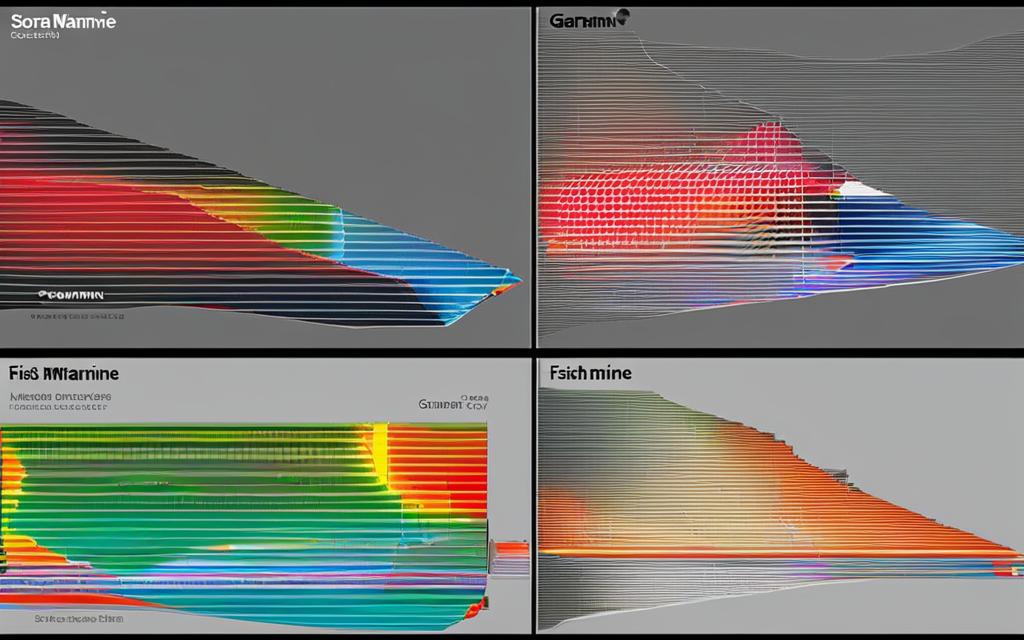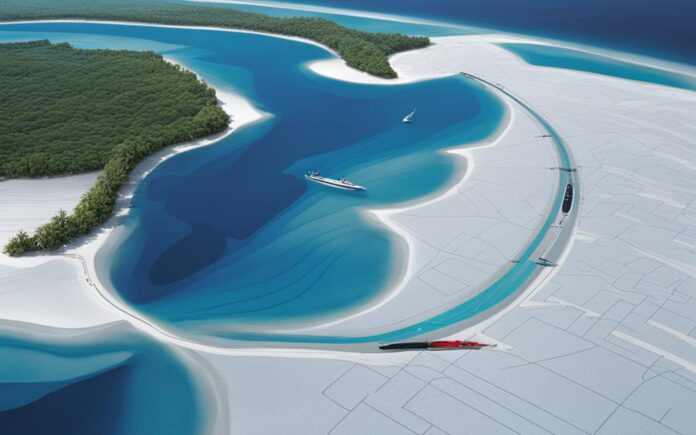As an Amazon Associate, I earn from qualifying purchases
When it comes to marine GPS systems, Raymarine and Garmin are two of the most notable brands in the market. If you’re in the market for reliable and feature-packed marine electronics, comparing these two giants is essential. Whether you’re looking for advanced charting capabilities, powerful sonar technology, or top-of-the-line radar features, both Raymarine and Garmin have something to offer for every avid sailor or angler.
In this article, we will delve into the features, functions, pros and cons of Raymarine and Garmin’s marine GPS systems. By understanding the specifics of each brand, you’ll be able to make an informed decision based on your individual needs and preferences.
Key Takeaways:
- Raymarine and Garmin are leading brands in the marine GPS market, offering reliable navigation systems.
- Raymarine excels in charting options and sonar capabilities.
- Garmin stands out in radar technology and screen display brightness.
- The best brand choice depends on individual requirements and priorities.
- Consider specific needs, such as charting capabilities, sonar technology, and radar features when making a decision.
Charting Options: Raymarine vs Garmin
When it comes to charting capabilities, Raymarine and Garmin offer distinct options that cater to different needs and preferences. Raymarine stands out for its versatility and flexibility, allowing users to explore various charting options and even integrate third-party apps into their navigation system. This means that you can choose from a wider range of charting solutions that suit your specific requirements.
Garmin, on the other hand, relies more on its proprietary charting technology. While this may limit the variety of charting options, Garmin’s in-house technology ensures consistently high-quality and reliable navigation experiences. It’s worth noting, however, that Garmin does offer support for Navionics, a popular third-party app known for its extensive charting features and data.
Overall, Raymarine provides more charting flexibility and the ability to integrate third-party apps, while Garmin delivers a robust charting experience through its proprietary technology, supplemented by Navionics support.
Raymarine Charting Options
Raymarine offers a wide range of charting options, including:
- Navionics+
- Navionics Platinum+
- C-MAP 4D
- C-MAP 4D MAX+
- Raymarine’s Lighthouse electronic navigation charts
Garmin Charting Options
Garmin provides its own charting technology along with support for Navionics, giving users access to:
- Garmin BlueChart g3
- Garmin BlueChart g3 Vision
- Navionics+
- Navionics Platinum+
Both Raymarine and Garmin offer comprehensive charting options, allowing boaters to navigate confidently and efficiently. Your choice between the two will depend on your preference for flexibility or proprietary technology.

Sonar Technology: Raymarine vs Garmin
When it comes to sonar technology, both Raymarine and Garmin utilize CHIRP (Compressed High-Intensity Radiated Pulse). This advanced sonar technology allows for better target separation and more detailed imaging of the underwater environment. However, Garmin takes it a step further with its higher power output, reaching up to 1 kilowatt.
“Garmin’s superior sonar technology enhances fish-finding capabilities and provides more detailed underwater images,” says marine electronics expert, Mark Thompson. “With its impressive power and performance, Garmin stands out in the industry.”
By leveraging its 1 kilowatt power, Garmin’s sonar technology delivers clearer and more accurate results, making it easier for anglers to locate and target fish. The higher power output allows for deeper penetration, ensuring that even bottom-dwelling species are not missed.
On the other hand, Raymarine’s sonar technology is still highly competent, providing reliable fish-finding capabilities. While it may not match Garmin’s power output, Raymarine’s CHIRP sonar technology offers a comprehensive and effective solution for anglers.
By combining CHIRP sonar technology with their respective fish finders, both Raymarine and Garmin provide anglers with the tools they need to maximize their fishing success.

Comparison of Sonar Technology: Raymarine vs Garmin
| Brands | Sonar Technology | Power Output (kilowatts) | Fish Finding Capabilities |
|---|---|---|---|
| Raymarine | CHIRP | 0.5 | Reliable and effective |
| Garmin | CHIRP | 1 | Superior and detailed |
A comparison of sonar technology between Raymarine and Garmin highlights Garmin’s impressive power output of 1 kilowatt, providing anglers with enhanced fish-finding capabilities and more detailed underwater images.
Radar: Raymarine vs Garmin
When it comes to radar capabilities, Raymarine and Garmin offer comparable options for marine GPS users. However, Garmin stands out for its more advanced radar technology, particularly in models like the Garmin Striker 7SV.
Both brands are known for their expertise in collision prevention and mapping features, providing accurate radar readings and enhancing safety during navigation. However, Garmin’s radar technology goes above and beyond by offering detailed mapping features that can greatly benefit users.
Having a reliable radar system is crucial for any marine GPS device, as it allows for better situational awareness and minimizes the risk of collisions with other vessels or obstacles. Whether you’re a professional sailor or a recreational boater, having access to accurate radar data can make a significant difference in your overall navigation experience.
The Benefits of Advanced Radar Technology
Garmin’s radar technology stands out for its advanced features and capabilities. It provides users with detailed mapping features, allowing them to see a clearer and more comprehensive picture of their surroundings.
By utilizing this advanced radar technology, Garmin users can have a greater understanding of their environment, even in challenging weather conditions or low visibility scenarios. The detailed mapping features offered by Garmin’s radar technology enable users to identify potential hazards, such as other vessels, land masses, or even upcoming storms, ensuring a safer and smoother navigation experience.
“Garmin’s radar technology offers users a comprehensive and accurate overview of their surroundings, maximizing safety and providing peace of mind during navigation.”
Additionally, Garmin’s radar technology is designed to integrate seamlessly with other mapping features on their devices, providing users with a unified and intuitive navigation experience. This integration allows for better coordination between different data sources, enhancing overall navigation efficiency and effectiveness.

Conclusion
In the ongoing debate between Raymarine and Garmin, it’s clear that both brands offer reliable marine GPS systems with their own distinct strengths. Raymarine stands out with its impressive charting options and advanced sonar technology, making it an excellent choice for those who prioritize precise navigation and detailed underwater imaging.
On the other hand, Garmin shines in terms of radar capabilities and screen display brightness. Its radar technology, especially in models like the Garmin Striker 7SV, offers detailed mapping features and enhanced collision prevention, ensuring a safer navigation experience.
When determining the best brand for your marine GPS needs, it’s crucial to consider your specific requirements and preferences. Raymarine is ideal for those seeking extensive charting options and exceptional sonar performance, while Garmin is the go-to choice for top-notch radar technology and bright screen displays. Ultimately, the decision comes down to individual priorities and the features that matter most to you.
FAQ
What are the main differences between Raymarine and Garmin marine GPS systems?
Raymarine excels in charting options and sonar technology, while Garmin stands out in radar capabilities and screen display brightness.
Does Raymarine support third-party charting apps?
Yes, Raymarine offers more variability and options for charting capabilities, including the use of third-party charting apps.
Does Garmin support third-party charting apps?
Garmin tends to rely on its own in-house technology, although it does support Navionics for enhanced charting features.
Which brand has better sonar technology?
Both Raymarine and Garmin utilize CHIRP sonar technology, but Garmin has superior power output, reaching up to 1 kilowatt.
How do the radar capabilities of Raymarine and Garmin compare?
Both brands excel in radar capabilities for collision prevention and mapping features, but Garmin tends to have more advanced radar technology.
Which brand has the brightest screen display?
Garmin stands out in screen display brightness, offering clear visibility even in bright sunlight.
What are the strengths of Raymarine and Garmin in terms of navigation systems?
Raymarine excels in charting options and sonar capabilities, while Garmin stands out in radar technology and overall screen brightness.
